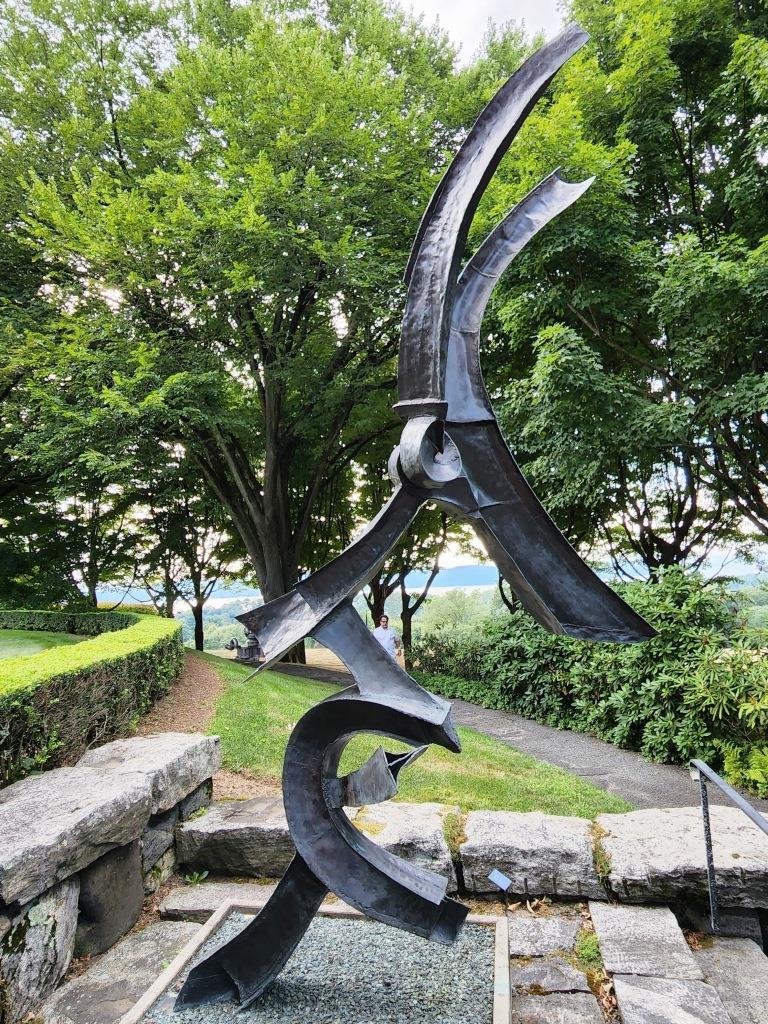Kykuit Sculpture Collection
Talin Kraft
Kykuit is a Rockefeller family estate, and, as you would expect, the grounds are beautiful. It was designed by Bosworth, one of the leading landscape architects of the beginning of the 20st century (his Untermyer Gardens are nearby and well worth a visit, it’s breathtaking). The house sits on a hilltop, so the grounds go down in various terraces, each landscaped differently: there is a Morning Garden, a Rose garden (that used to be a maze for the children), a Japanese Garden, a Brook garden, an Italian Garden, Grand Staircase, a Temple of Venus with an Italian Grotto underneath. There are fountains and pools, a teahouse, a waterfall, several pavilions and gazebos. It’s really nice to stroll around, and when you get to the west side, the views of the Hudson River are spectacular.
The Italian Grotto, a circular room beneath the Temple of Venus, features Giacomo Balla’s series of wooden sculptures, Futuristic Flowers. They are really fun.
But, as beautiful as the gardens are, we’re here for the sculptures! The collection is brilliant. While the classical pieces were bought by John D. Rockefeller and his son, John Rockefeller Jr., it’s the youngest owner, Nelson Rockefeller (grandson of JDR and second son of John Rockefeller Jr.) we have to thank for the stunning selection of modern sculpture.
Nelson was known for his love for art, especially contemporary art, among other things. He was largely responsible for the artist choices at the Rockefeller Center, where he was president and chairman, and he also served as trustee and later president of MoMA. There’s an excellent art gallery in the basement of the Kykuit main house (sadly, photography is not all0wed), but it seems that his true passion was sculpture. There are over 70 pieces of modern sculpture scattered around the estate (he liked to be involved in the placement of the sculptures and had an eye for finding the best location for each. To find the perfect spot, he frequently moved the pieces from place to place by helicopter).
The collection has plenty of famous, acclaimed names, but it’s relatively unknown and obscure artists who drew my attention most. There are amazing pieces by some artists I’ve never even heard about. It was an eye opening experience. Let’s see some of these new discoveries.
Experimenting with a human figure:
Fritz Wotruba, 1907-1975. An Austrian sculptor of Czecho-Hungarian descent. He obviously likes cubism. His Reclining Figure reminds me of some works by Antony Gormley, who likes to experiment with pixelated human figures.
Jean Ipousteguy, 1920-2006. A French sculptor. He likes to mix figurative and abstract elements in various representations of the human form.
Appreciating elements of nature:
Peter Chinni, 1928-2019. An American sculptor and painter. His Natura Extensa is a very abstract representation of a sprouted seed, with new life form bursting out of split core. This is probably my favorite piece out of entire collection.
Shinkichi Tajiri, 1923-2009. A Japanese-American sculptor. He was a very versatile artist, working in several very different directions. One of his favorite themes is knots, another - elements of nature in various stages of disintegration. This Seed on the verge of bursting is an example of the later theme. He was deeply affected by the war (he participated in active service), so in a lot of his artworks the life and death are always entangled, there’s no one without another.
Umberto Mastroianni, 1910-1998. An Italian abstract sculptor, and an uncle of the actor Marcello Mastroianni. His deal is lots of sharp angles.
Exploring line, shape, and surface:
Herbert Ferber, 1906-1991. An American sculptor and painter. His sculptures seem to be a challenge: to gravity, to staticity, to continuous surface. It’s a bit distressing.
Max Bill, 1908-1994. A Swiss architect, artist, painter, designer. He’s interested in geometry, in both his paintings and sculptures.
Gio Pomodoro, 1930-2002. An Italian sculptor, jeweler, and stage designer. He’s also a brother of much more famous Arnaldo Pomodoro (who is also present in the collection). This undulating surface is very typical for him.
Sorel Etrog, 1933-2014. A Romanian-born Israeli-Canadian artist, sculptor, writer, and philosopher. He seems to like very complicated, knotted lines and figures.
Abstraction on a vertical line:
Mirko Basaldella, 1910-1969. An Italian sculptor and painter. He has an impressive range - from figurative, somewhat primitive animals to vaguely human-like or sometimes totem pole-like vertical figures to incredibly complex combinations of various pieces and patterns.
Ezra Orion, 1934-2015. An Israeli sculptor. He’s interested in Cosmos, his sculptures are a stairway to Heaven. Once, he executed an "Intergalactic Sculpture" by sending a Laser beam to the Milky Way.
Robert Adams, 1917-1984. An English sculptor and designer. I actually saw his small scale sculptures before. His shapes are somewhat organic and very pleasing. But in his monumental works, different aesthetic comes forward, which was called ‘Geometry of Fear’ by some critics.
And finally, pure goofiness:
Karel Appel, 1921-2006. A Dutch painter, sculptor, and poet. His imagery is rooted in children artworks, he likes eccentric creatures, bold colors, and expressive emotions.
And of course, there are plenty of well-known, household names from the classics of modernism such as Brancusi and Giacometti to later, even more abstract works of Fontana and Tony Smith. This collection is simply superb. You can find the other pieces from the same editions or slightly different versions of these sculptures in major museums and on the top Ivy League Universities campuses.












































